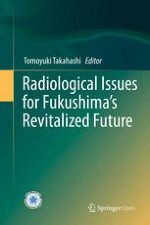3.1 Introduction
3.2 Materials and Methods
3.3 Results and Discussion
Weight (g) | Radioactivity of 137Cs (Bq) | Specific activity (Bq/kg) | Recovery ratio | |
|---|---|---|---|---|
1st column | 0.87 | 16.4 ± 0.2 | ||
2nd column | 1.49 | 12.8 ± 0.2 | ||
Total (15 kg seawater) | 29.2 ± 0.3 | 1.95 ± 0.02 | 0.97 ± 0.10 | |
Initial [7] | 2.0 ± 0.2 |
Radioactivity | ||||||
|---|---|---|---|---|---|---|
Sample | Dry weight (g) |
134Cs (Bq) |
137Cs (Bq) | Radioactivity ratio of 134Cs/137Cs | Collection date | Location |
Soil | 12.98 | 3.4 ± 0.3 | 4.0 ± 0.1 | 0.87 ± 0.07 | 15 September 2011 | Hinoemata |
Litter | 15.90 | 6562 ± 57 | 6194 ± 43 | 1.06 ± 0.01 | 23 May 2011 | Iitate |
Seaweed | 17.78 | 10.4 ± 0.5 | 10.7 ± 0.2 | 0.97 ± 0.05 | 25 August 2011 | Iwaki |
Seawater | AMP-PAN | 28.9 ± 0.9 | 29.2 ± 0.3 | 0.99 ± 0.03 | 25 August 2011 | Iwaki |
Isotopic ratio of 134Cs/137Cs | |||||
|---|---|---|---|---|---|
Sample | γ-spectrometry | TIMS | Isotopic ratio of 135Cs/137Cs | Distance from FDNPP | Reference |
Soil | 0.059 ± 0.005 | Not detected | Not detected | WSW, 160 km | This work |
Litter | 0.073 ± 0.001 | 0.0691 ± 0.0014 | 0.3574 ± 0.0020 | NW, 34 km | |
Seaweed | 0.067 ± 0.003 | Not evaluated | Not evaluated | SSW, 55 km | |
Seawater | 0.068 ± 0.003 | Not evaluated | 0.3617 ± 0.0051 | SSW, 55 km | |
Grass | 0.069 ± 0.009 | 0.0722 ± 0.0004 | 0.3622 ± 0.0006 | NW, 42 km | [6] |
Bark | 0.067 ± 0.002 | 0.0698 ± 0.0005 | 0.3663 ± 0.0005 | NNW, 3 km | |
Root | 0.069 ± 0.001 | 0.0684 ± 0.0008 | 0.3586 ± 0.0008 | WNW, 8 km | |
Moss | 0.070 ± 0.000 | 0.0713 ± 0.0003 | 0.3663 ± 0.0007 | SSW, 2 km | |
